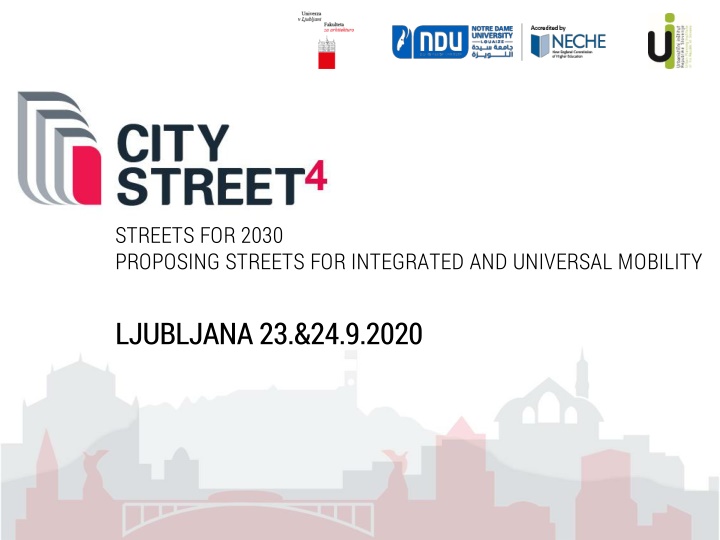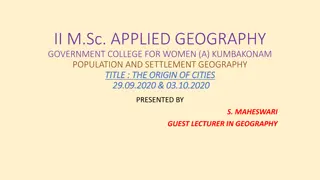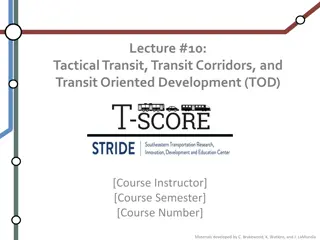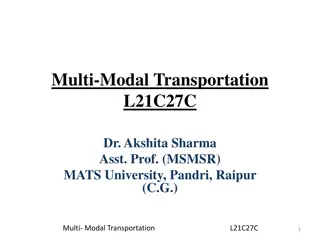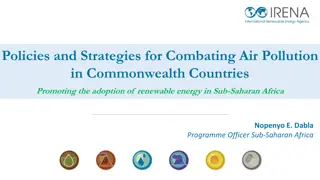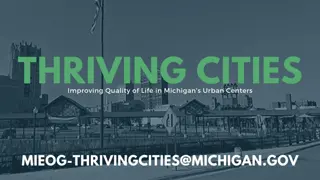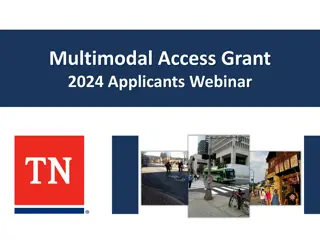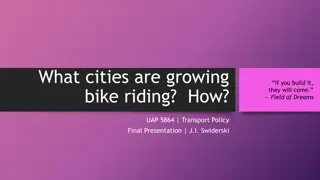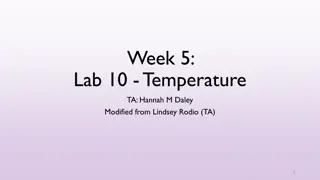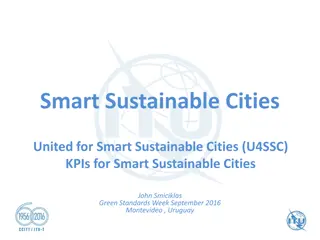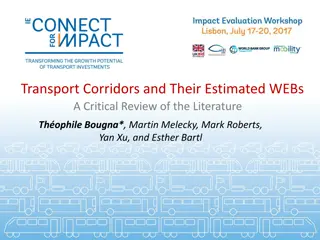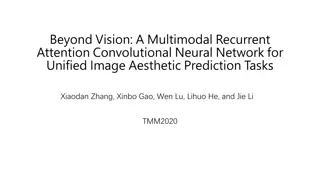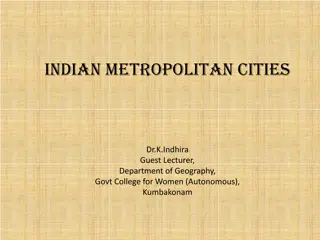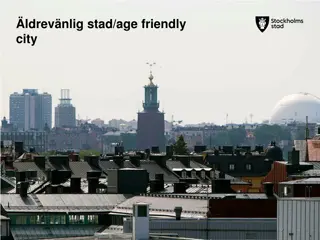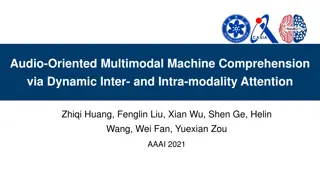Sustainable Multimodal Corridors for Integrated Cities
This research focuses on formulating compact methods for creating multimodal corridors in metropolitan cities, emphasizing sustainable modes of transportation. Through the integration of urban and traffic dimensions, the aim is to enhance accessibility and livability for all users.
Download Presentation

Please find below an Image/Link to download the presentation.
The content on the website is provided AS IS for your information and personal use only. It may not be sold, licensed, or shared on other websites without obtaining consent from the author.If you encounter any issues during the download, it is possible that the publisher has removed the file from their server.
You are allowed to download the files provided on this website for personal or commercial use, subject to the condition that they are used lawfully. All files are the property of their respective owners.
The content on the website is provided AS IS for your information and personal use only. It may not be sold, licensed, or shared on other websites without obtaining consent from the author.
E N D
Presentation Transcript
STREETS FOR 2030 PROPOSING STREETS FOR INTEGRATED AND UNIVERSAL MOBILITY LJUBLJANA 23.&24.9.2020
STEFANOS TSIGDINOS, PhD Student NTUA, stef.tsigdinos@gmail.com THANOS VLASTOS, NTUA Professor, vlastos@survey.ntua.gr FORMULATING MULTIMODAL CORRIDORS TOWARDS SUSTAINABLE MOBILITY IN A METROPOLITAN CITY
Contents 1. Introduction 2. Methodology 3. Study area and Results 4. Conclusions
Introduction Car dominance traffic congestion, environmental degradation, road accidents, inaccessible public spaces etc. (Nieuwenhuijsen and Khreis, 2016) Essential solutions towards sustainable and just cities: Integrated urban and transport planning Sustainable mobility (Bannister, 2008) Fundamental planning tool of both transport and urban planning procedure: Street functional classification Highlights the role of each road segment in the whole transport system (FHWA, 2013) Should be multimodal and especially oriented to sustainable modes
Introduction Crucial part of alternative classification systems: Multimodal corridors Urban corridors that promote multimodal mobility and accommodate the movement of sustainable modes (Curtis and Tiwari., 2008) Key strategy in spatial policy in cities (Ruming, 2014) Component of an integrated transport and planning approach Tool for reconceptualizing large urban streets and thus enhancing accessibility for all users, improving livability (Moore et al., 2007; Williams and Seggerman, 2014)
Introduction Aim of the research Formulation of multimodal corridors in a metropolitan city More specifically, we suggest a compact method for formulating multimodal corridors classification system which takes into consideration both urban and traffic dimension of the city and prioritizes sustainable modes an integrated
Methodology Proposed method for formulating multimodal corridors The method was developed through literature review and on-site observations
Methodology Step 1 Analysis of study area in order to identify potentials Urban dimension a) Urban identity of main road network, b) Identification of the compact urban core and c) Major urban centres Transport dimension a) Existing strategic network, b) main public transport routes, c) metropolitan cycling routes and d) total road width Step 2 Multimodal corridors I: Planning stage Adoption of a two-dimensional matrix based approach Step 3 Multimodal corridors II: Design stage
Methodology Two dimensional matrix Dimension 1 Significance of road segment (Step 2a) Categories Intermunicipal Citywide Criteria: a) Connectivity, b) multimodality indicator and c) shortest path algorithm Dimension 2 Prioritazion of transport modes (Step 2c) Categories Mixed (public transport and car) Sustainable modes (active modes, micromobility and public transport) Criterion: a) Geography (position in relation with ring road zones)
Methodology Significance Metropolitan route Connects significant centres outside the main urban core with metropolitan centres of Attica Citywide route Is generated by the application of the shortest path algorithm Shortest path algorithm: Vertices Major urban centres inside the main urban core, Edges Existing strategic road network
Methodology Ring Roads Outer ring road consists of Metropolitan significance routes contribution to the diversion or regional through traffic Inner ring road consists of Circumferential routes of metropolitan significance with mixed priority protection of historic and commercial centre
Methodology Priority Metropolitan route Mixed priority: in segments inside the main urban core but outside of the inner ring road Sustainable modes: in segments inside the inner ring road Citywide route Mixed priority: in segments inside the main urban core but outside of the inner ring road Sustainable modes: in segments inside the inner ring road
Study area & Results Main urban core of Metropolitan Athens Average car use:53% Diverse urban, social and environmental characteristics Athens Serious urban sprawl but at the same time strong metropolitan centers. Population: Approx. 3,0 million residents Area: 414.092 km Consists of 40 municipalities
Study area & Results Data Sources Ministry of Environment & Energy National Technical University of Athens Hellenic Statistical Authority Open Street Map
Study area & Results Current strategic road network Car-oriented Undermines the role of sustainable means of transport Allows the traffic penetration of the main urban core by major arterials Major severances to the urban fabric Low level of readability Urgent need for transformation
Study area & Results Planning stage: Proposed multimodal corridors Metropolitan (63%) Mixed: 96,0% Sustainable means: 4,0% Citywide (37%) Mixed: 90,7% Sustainable means: 9,3% Total length: 237,5km Reduce of car oriented streets: 35,9% Protection of central areas
Study area & Results Metropolitan-mixed priority Speed: up to 60-70km/h, Car movement: Signalized junctions, 2 lanes for car circulation per direction (including EVs) Autonomous vehicles: Separate lanes for safe circulation Public transport: Tram or BRT (signal priority), Cycling infrastructure: Separate (protected from cars), Pedestrian infrastructure: Adequate or moderate (removal of obstacles, crosswalks, widening of sidewalks, curb ramps), Land uses: Vehicle-oriented or pedestrian friendly, Streetscape features: Greenery, benches On-street parking: restricted Metropolitan-sustainable modes Speed: up to 40-50km/h, Car movement: Signalized junctions, 1-2 lanes for car circulation per direction (including EVs) Autonomous vehicles: Mixed lanes due to low speed limits Public transport: Tram or BRT (signal priority), Cycling infrastructure: Separate or roadway, Pedestrian infrastructure: Enhanced (removal of obstacles, more crosswalks, widening of sidewalks, curb ramps), Land uses: Pedestrian friendly Streetscape features: Greenery, benches, porches, parklets On-street parking: Restricted
Study area & Results Citywide-mixed priority Speed: up to 50-60km/h, (mainly 50km/h) Car movement: Signalized junctions, 1-2 lanes for car circulation per direction (including EVs) Autonomous vehicles: Separate lanes for safe circulation Public transport: Streetcar or bus (high frequency), Cycling infrastructure: Separate or roadway, Pedestrian infrastructure: Moderate or enhanced (removal of obstacles, crosswalks, widening of sidewalks, curb ramps), Land uses: Vehicle-oriented or pedestrian friendly, Streetscape features: Greenery, benches, porches, parklets On-street parking: Mainly restricted Citywide-sustainable modes Speed: up to 30-40km/h, (mainly 30km/h) Car movement: Signalized or non-signalized junctions, 1 lane for car circulation per direction Autonomous vehicles: Mixed lanes due to low speed limits Public transport: Streetcar or bus (high frequency), Cycling infrastructure: Separate or roadway, Pedestrian infrastructure: Enhanced (removal of obstacles, more crosswalks, widening of sidewalks, curb ramps), Land uses: pedestrian friendly Streetscape features: Greenery, benches, porches, parklets On-street parking: Mainly restricted
Conclusions Findings Introduction of a methodological tool for formulating multimodal corridors in large cities The proposed method will contribute to: Readability of the strategic corridors Unification of urban fabric Promotion of sustainable modes Reduction of car oriented roads Enhancement of accessibility for all users Connection of planning and implementation activities
Conclusions Findings The current research has notable value as it deals with the integration of multimodality in a car-oriented urban environment, thus enriching the existing literature The proposed methodology could function as a decision support tool for the planning process and could be applied to other cities with similar characteristics. The approach introduced in the research should influence the existing institutional aspects of urban and transport planning procedures
Conclusions Further research Creation of a complete evaluation framework Adoption of a participatory planning approach, engaging residents and stakeholders Integration of new criteria and tools, especially data- driven and evidence-based methods
Thank you for your attention! Stefanos Tsigdinos - stef.tsigdinos@gmail.com Thanos Vlastos -vlastos@survey.ntua.gr
